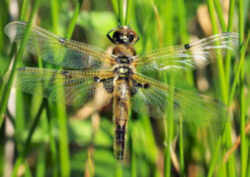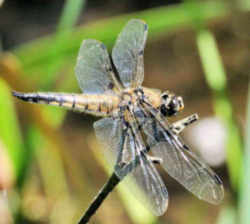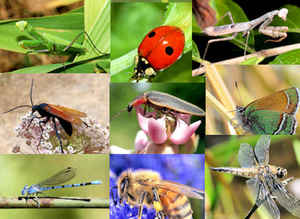Alaska State Insect
Four-Spotted Skimmer
 DragonFly
DragonFly
(Libellula quadrimaculata)
Adopted on August 24, 1995
The four spot skimmer dragonfly, (Libellula quadrimaculata,) per legislation (HB 239) introduced by Senator Georgianna Lincoln on behalf of elementary students in her district, and passed by the 19th Legislature on August 24, 1995. (Ch 49 SLA 95).
After a campaign by students from the Auntie Mary Nicoli Elementary School in Aniak, the winner is the four-spot skimmer dragonfly. It mauled the mosquito. It battered the butterfly. And it bested the bumblebee in a tight contest to be the Last Frontier's official insect.
After the votes were tallied from every public school in the state, the dragonfly downed the mosquito 3,914 to 3,035. In a sponsor statement for House Bill 239, which Gov. Knowles signed into law in May, Rep. Irene Nicholia stated a reason the dragonfly was more worthy to represent the state than the mosquito: "The dragonfly's ability to hover and fly forward and backward reminds us of the skillful maneuvering of the bush pilots in Alaska."
Alaska State Insect: Four-Spotted Skimmer

The Four-spotted
Chaser (Libellula quadrimaculata), known in North America as the Four-spotted Skimmer, is a dragonfly of the family Libellulidae found frequently
throughout Europe, Asia, and North America.
The adult stage is found between April to early September in the United Kingdom, and from mid-May to mid-August in Ireland. Larvae have a two year
developmental cycle. Adults feed predominantly on mosquitoes, gnats and midges; the larvae feed primarily on other aquatic insect larvae and on tadpoles.
There is a variant form, praenubila Newman, which has exaggerated wing spots. This is believed to be related to water temperatures during larval development,
and appears to be more common in Europe than in the Americas.
Characteristics of the Four-Spotted Skimmer
Naiad-
- Medium to large naiad, with a length of 7/8 to 1 1/16 inches (22 to 26 mm).
- Orange-brown in color
- Abdomen is rounded, giving it a short, stocky appearance known as the sprawler form. Small hook exists on the top of abdominal segments three through eight, while the hooks on segments five through seven are noticeably larger. Also a small, rear-facing spine on each side of abdominal segment eight and nine.
Adult-
- Medium-sized dragonfly with a length of 1 5/8 to 1 13/16 inches (40 to 45 mm).
- Wings clear except for along the leading edge, which is clouded with a transparent yellowish brown. Center of each wing is marked with a small dark spot, also on the leading edge. Additionally, each hind wing is marked with a dark patch near the base.
- Males and females look alike, generally dark brown.
- Face and each side of the thorax are marked with patches of greenish yellow.
- Sides of the abdomen lined with yellowish orange dashes.
Key Identification Features
- Small brown patch on the middle of the leading edge of each wing, this combined with the dark pterostigma is the origin of the name "Four-spotted Chaser".
- Brown tapering abdomen, becoming black towards the posterior end.
- Yellow markings on sides of abdomen.
- Dark brown patch at the base of the wings.
Range
Labrador to New Jersey, southwest to Arizona, north to British Columbia, Alberta, and Alaska.
Habitat
Near ponds or broad, slow parts of rivers, sometimes straying to open woods.
Adult Flight Season
Early April to mid-August
Diet
Naiad- Feeds on small aquatic insects.
Adult- Eats small flying insects.
Ecology
The naiad does particularly well in acidic bogs, and lives in the debris on the bottom of lakes, ponds, bogs, and marshes. They do not actively pursue prey but wait for it to pass by, a strategy which affords them protection from other predators. Naiads emerge as adults at night. Adults generally fly from early April to mid-August. Hunting occurs from perches on twigs or rocks. This is the only Libellula species in our area in which the males do not become pruinose. Although it does not regularly migrate in North America, this species has been known to migrate in Europe, generally in 10 to 15-year cycles. The direction of the migration varies, and the migrations are thought to be triggered by a trematode parasite (it is known that several types of parasites can cause unusual behaviors in their hosts that promote the dispersal of the parasite). This species has also been known to form large swarms in Europe, often covering 100 square miles (roughly 300 square km).
Reproduction
After males and females mate, the female flies singley, without the male attached, to lay her eggs. She does this by dipping the tip of her abdomen in the water while hovering just above its surface.
Alaska Law
The law designating the four spot skimmer dragonfly as the official Alaska state insect is found in the Alaska Statutes 2015, Title 44, Chapter 09, Section 44-09-130
TITLE 44. STATE GOVERNMENT
Chapter 44.09 STATE SEAL, FLAG, AND EMBLEMS
Sec. 44.09.130. State insect.
The four spot skimmer dragonfly is the official state insect
HISTORY
(Sec. 1 ch 49 SLA 1995)
Taxonomic Hierarchy: Four-Spotted Skimmer Dragonfly
Kingdom: Animalia (Animals)Phylum: Arthropoda (Arthropods)
Subphylum: Hexapoda (Hexapods)
Class: Insecta (Insects)
Order: Odonata (Dragonflies and Damselflies)
Suborder: Anisoptera (Dragonflies)
Family: Libellulidae (Skimmers)
Genus: Libellula
Species: quadrimaculata (Four-spotted Skimmer)
Butterflies, and Bugs








